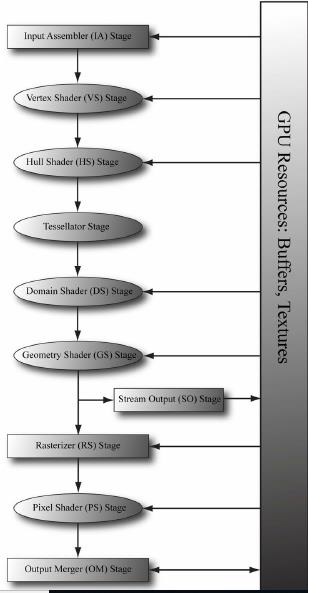
- DirectX - Home
- 3D MATHS
- 3D Maths - Vector Algebra
- 3D Maths - Matrix Algebra
- 3D Maths - Transformations
- 3D Maths - DirectX Math
- DIRECTX
- DirectX - Overview
- DirectX - Installation
- DirectX - Components
- DirectX - Tools
- DirectX - Creating App
- DirectX - Window Events
- DirectX - App Lifecycle
- DirectX - Direct3D Initialization
- DirectX - First HLSL
- DirectX - Graphics Pipeline
- DirectX - Buffers
- DirectX - 3D Transformation
- DirectX - Drawing
- DirectX - Rendering
- DirectX - Modeling
- DirectX - Lighting
- DirectX - Texturing
- DirectX - Multi Texturing
- DirectX - Blending
- DirectX - Picking
- DirectX - Stenciling
- DirectX - First Shader
- DirectX - Pixel Shader
- DirectX - Geometry Shaders
- DirectX - Compute Shaders
- DirectX - Shader Effects
- DirectX - Quaternion
- DirectX Resources
- DirectX - Quick Guide
- DirectX - Useful Resources
- DirectX - Discussion
DirectX - Graphics Pipeline
The theme of this chapter is to understand rendering pipeline, also called as Graphics Pipeline. Consider the geometric description of a 3D scene with a positioned and oriented virtual camera which calls the rendering pipeline. This pipeline includes entire sequence of steps necessary to generate 2D images based on what the virtual camera sees.
Before we start understanding the rendering pipeline, we should understand two basic steps −
- 3D Illusion
- Representation of colors which works mathematically
The figure mentioned below includes stages that make up the rendering pipeline. The direction mentioned from the memory pool to stage can access the resources as a specific input.
The best illustration is the pixel shader stage to read data from a texture resource stored in the memory.
The figure includes an arrow going from a stage to memory, i.e., the stage which writes to the mentioned GPU resources. The best example is the output merger stage which is considered as bidirectional. The other example is Vertex shader stage which takes input from data from the Input Assembler stage and generates the output to Geometry Shader stage.
The subsequent sections give an overview of each stage of the rendering pipeline. The sections are namely −
- Buffers
- Textures

Buffers comprise of Input Assembler, Vertex Shader and Hull Shader stages. The other stages are included within the section of textures. It also includes stream output stage which is depicted in the snapshot above. This stage gives respective output to the user. The description of all stages are described in later sections of this tutorial.